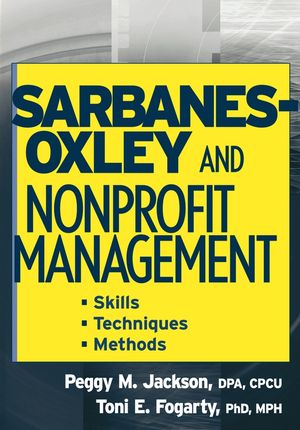Sarbanes-Oxley and Nonprofit Management: Skills, Techniques, and MethodsISBN: 978-0-471-75419-0
Paperback
336 pages
February 2006
 This is a Print-on-Demand title. It will be printed specifically to fill your order. Please allow an additional 10-15 days delivery time. The book is not returnable.
|
||||||
Preface.
Chapter 1: History and Legislative Background of the Sarbanes-Oxley Act of 2002.
Chapter Overview.
Chapter Objectives.
Passage of the Sarbanes-Oxley Act of 2002.
Analysis of the Legislative and Regulatory Content of SOX.
Factors that Drove the Swift Passage of SOX.
Implications of SOX for Nonprofits.
Conclusion.
Worksheet: SOX and Relevance to Nonprofit Operations.
Chapter 2: SOX Requirements, Best Practices, and State Legislation.
Chapter Overview.
Chapter Objectives.
What Are Nonprofits Required to Do Under SOX?
SOX Best Practices.
Benefits of Implementing Best Practices—Adding Value to the Nonprofit.
Nonprofits: Current Legislative Environment.
Example of State Legislation—California’s “Nonprofit Integrity Act” (SB 1262).
Conclusion.
Chapter 3: Anatomy of a Dysfunctional Nonprofit: Diagnosing of Organizational Dysfunction.
Chapter Overview.
Chapter Objectives.
Organizational Culture.
Conclusion.
Chapter 4: Root Cause Analysis Part I: Three Nonprofit Crises.
Chapter Overview.
Chapter Objectives.
American Red Cross National Headquarters and Post-September 11th Fundraising and Blood Collection.
Background.
United Way of the National Capital Area.
James Beard Foundation.
Factors, Common and Unique, and Lessons Learned.
Conclusion.
Chapter 5: Root Cause Analysis—Part II.
Chapter Overview.
Chapter Objectives.
Summary of Finding from Root Cause Analysis—Part I.
Whistleblower Protection.
Document Preservation Policy.
SOX Best Practices.
Conclusion.
Chapter 6: SOX Best Practices and Governance.
Chapter Overview.
Chapter Objectives.
Role of the Board in Today’s Nonprofit.
Conclusion.
Chapter 7: SOX Best Practices and the Nonprofit Executive Team.
Chapter Overview.
Chapter Objectives.
Conclusion.
Chapter 8: Sarbanes-Oxley Best Practices and Information Technology.
Chapter Overview.
Chapter Objectives.
Benefits of Implementing Sarbanes-Oxley Best Practices.
Conclusion.
Chapter 9: Human Resource Management—Sarbanes-Oxley Requirements and Best Practices.
Chapter Overview.
Chapter Objectives.
Whistleblower Protection.
Why Individuals Are Reluctant to “Blow the Whistle” on Waste, Fraud, and Abuse.
Creating a Confidential Reporting System.
Travel Claims and Reimbursement Policies.
Employees or Independent Contractors? Why the IRS Wants to Know.
Protecting the Privacy of Staff and Volunteers.
Conclusion.
Chapter 10: Sox Best Practices and Fundraising.
Chapter Overview.
Chapter Objectives.
The Changing Legislative Environment’s Impact on Fundraising Practices.
Example of State Law Relative to Fundraising: Provisions of California’s SB 1262 Nonprofit Integrity Act to Fundraising Activities.
The Role of the Board and Executive Team in Providing Oversight and Guidance to a Nonprofit’s Fundraising.
Best Practices and Industry Standards for Fundraising and Development.
Internal Controls and Ethical Considerations for Fundraising.
Conclusion.
Chapter 11: SOX Best Practices and Internal Controls.
Chapter Overview.
Chapter Objectives.
Need for an Internal Control System.
Advantages of Adopting SOX Best Practices Regarding Internal Controls.
What Is an Effective Internal Control System?
Committee of Sponsoring Organizations.
Importance of Internal Financial Controls.
Conclusion.
Worksheet 1: Conducting an Internal Control System Review.
Worksheet 2: Questions for the Senior Management and the Board of Directors.
Chapter 12: The Financially Literate Board.
Chapter Overview.
Chapter Objectives.
Need for a Financially Literate Board of Directors.
Determining Board Competence in Financial Matters.
Adult Learners and Learning Styles.
Content that Should Be Covered.
Annual Budget.
Conclusion.
Worksheet: Developing a Financial Literacy Training Plan.
Chapter 13: SOX Best Practices and Legal Compliance.
Chapter Overview.
Chapter Objectives.
Need for Board Oversight.
Three Duties of the Board of Directors.
The Importance of an Audit.
Working with the IRS.
Working with Attorneys.
Conclusion.
Worksheet: Legal Compliance Review.
Chapter 14: Sox Best Practices and Political Competence.
Chapter Overview.
Chapter Objectives.
Developing Political Competence.
Role of Nonprofits.
Two Components in Political Competence.
Alignment with Others.
Arguments against Exercising Political Competence.
Helpful Websites for the Nonprofit Developing Its Political Competence.
Conclusion.
Worksheet: Pressures for Nonprofit Reform.
Appendix.
Bibliography.
About the Authors.
Index.



